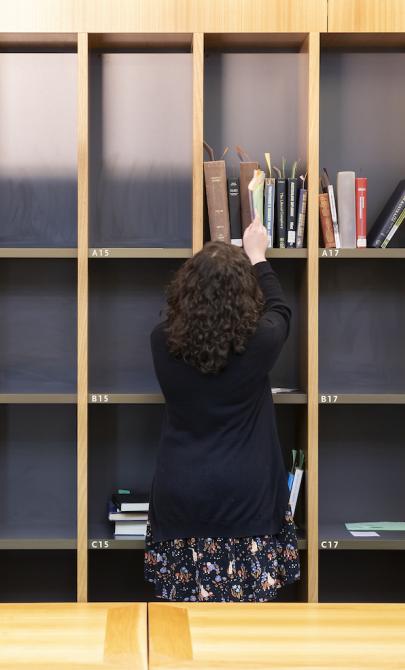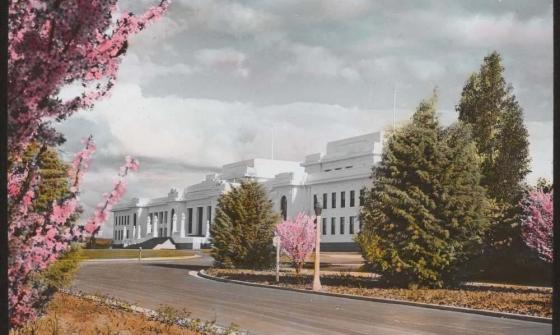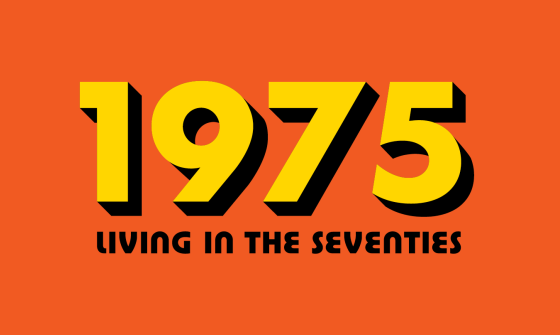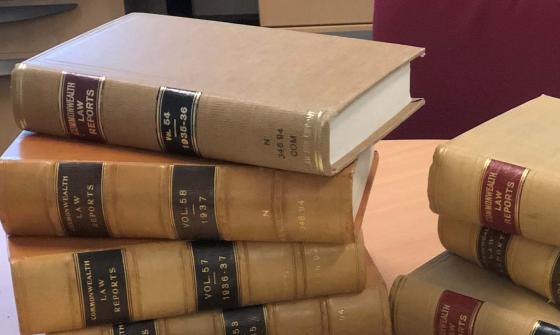Mabo Collection
Key items in the collection
Our 2 Mabo collections offer an incredible look into one of Australia’s most significant and debated legal cases, as well as the life of Edward Koiki Mabo, who is closely connected to it. In 2001, their importance was officially recognised when, along with James Cook's Endeavour journal, they became the first Australian collections added to UNESCO's Memory of the World register.
Personal papers of Edward Koiki Mabo
Most of Mabo's personal papers cover the last 20 years of his life, though there are a few from earlier times. A special highlight is a series of letters he wrote to Bonita Mabo around their 1959 marriage, during a time when he was working as a fettler near Hughenden while she lived in Townsville.
His later papers include job applications, references, verses, pencil sketches, documents on his attempt to visit Mer in 1973-74, and correspondence from after his death. Eight diaries (1976-92) provide details on his work with the Aboriginal and Torres Strait Islander Commission, his involvement in the High Court case, his health, and hopes for his family. The last diary entries were made two weeks before he passed away.
There are also extensive papers about Mabo's business ventures, especially his fishing company, the Meriam Trading Company (later Meriam Enterprises, 1982-91). Additional papers cover his work with the Black Community School in Townsville, where he served as a director, and his involvement in community groups like the National Aboriginal Education Committee, the ABIS Community Cooperative Society, the Torres Strait independence movement, and Aboriginal legal aid services.
The earliest records on the Murray Island land claim include a manuscript and typescript of Mabo's speech at the 1981 Land Rights and Future of Australian Race Relations Conference at James Cook University. Other documents feature his correspondence with solicitor Greg McIntyre and the Murray Island Council, traditional land maps of Mer, Mabo family genealogies, Mabo's notes, academic papers, and newspaper clippings.
Papers relating to the Mabo cases
The litigation papers from Bryan Keon-Cohen QC (MS 9518) provide thorough documentation of the 2 Mabo cases, Mabo (No. 1) (1988) and Mabo (No. 2) (1992), arranged chronologically from the initial Plaintiffs' Statement of Facts (1982).
These papers cover various stages of the case, including Mabo’s testimony, materials supporting the Demurrer application in the High Court (Mabo (No. 1)), trial transcripts from the Queensland Supreme Court (1989), final submissions from both sides, Justice Moynihan's determination of facts (1990), the plaintiffs' High Court submissions (1991), and High Court hearing transcripts.
The trial exhibits are valuable for research and include anthropological reports from the late 1800s, statements by Torres Strait Islanders, and maps and photographs of Murray Island’s property boundaries.
The files also include materials from Greg McIntyre, the plaintiffs' solicitor, such as draft advice, pleadings, and correspondence with clients, witnesses, counsel, opposing solicitors, legal aid agencies, archivists, and more. Additional items include meeting minutes from Murray Island, press clippings, pamphlets, and publications.
We also hold papers of the academics Henry Reynolds (MS 9548) and Nonie Sharp (MS Acc06/51) which contain a good deal of material on the Mabo Case.
There are four cassette recordings from conversations between Noel Loos and Edward Koiki Mabo in 1984, which became the foundation for Loos's book, Edward Koiki Mabo: His Life and Struggle for Land Rights (1996). There’s also an undated recording of Mabo talking and singing, another of a lecture he gave at Townsville College of Advanced Education, and a recording from part of the 1981 conference on land rights and the future of Australian race relations, held at James Cook University.
Mabo enjoyed sketching, and his work includes 6 pieces: a painted self-portrait, three watercolours, and two drawings. These feature a still life, a tree study, dancing figures, a bay scene, and two islands.
The collection also includes copies of nine photographs of Mabo. One of these shows him on a visit to Murray Island with barristers Ron Casten and Bryan Keon-Cohen. There are numerous photos of Bonita Mabo as well, including 20 taken by Loui Seselja at the National Library in 2001.
The following two works deal with the life of Edward Koiki Mabo:
- Trevor Graham, Mabo: life of an island man, 1999 [screenplay of the film produced by Film Australia and post-production script]
- Noel Loos and Koiki Mabo, Edward Koiki Mabo: his life and struggle for land rights, 1996
The High Court decision in the Mabo Case led to a spate of books and pamphlets, some of which expressed extreme views. The following are a few of the more substantial studies:
- Bain Atwood, ed., In the age of Mabo: history, Aborigines and Australia, 1996
- Richard H.Bartlett, ed., The Mabo decision, and the full text of the decision in Mabo and others v. State of Queensland, 1993
- Toni Bauman and Lydia Glick, eds., The limits of change: Mabo and native title 20 years on, 2012
- Frank Brennan, One nation, one land: Mabo – towards 2001, 1995
- P.J. Butt and Robert Eagleson, Mabo: what the High Court said, 1993
- Department of the Parliamentary Library, Mabo papers, 1994
- Murray Goot and Tim Rowse, eds, Make a better offer: the politics of Mabo, 1994
- Bryan Keon-Cohen, Mabo in the courts: Islander tradition to native title: a memoir, 2011
- Grant Nettheim Mabo (1992) [and the three following entries], The Oxford Companion to the High Court of Australia, 2001, pp. 446-52
- Tim Rowse, After Mabo: interpreting indigenous traditions, 1993
- Peter H. Russell, Recognising Aboriginal title: the Mabo case and indigenous resistance to English-settler colonialism, 2006
- Nonie Sharp, No ordinary judgment: Mabo, the Murray Islanders' land case , 1996
- M.A. Stephenson, ed., Mabo: the native title legislation, 1995
- M.A. Stephenson and Suri Ratnapala, eds., Mabo, a judicial revolution: the Aboriginal land rights decision and its impact on Australian law, 1993
- Galarrwuy Yunupingu, ed., Our land is our life: land rights – past, present and future, 1997
About Edward Koiki Mabo
Edward Koiki Mabo (1936-1992) was born on Mer (Murray Island) in the Torres Strait. After his mother died during childbirth, he was adopted by his uncle and aunt, Benny and Mauga Mabo, according to customary law. Mabo attended school on Murray Island, where he learned to speak English fluently. After working on trochus fishing boats for a few years, he moved to mainland Australia in 1957. He worked as a canecutter, railway worker, and labourer for the Townsville Harbour Board, becoming active in trade unions, representing Torres Strait Islanders on the Townsville-Mount Isa railway project.
Involvement in activism
Mabo began working at Townsville University College (now James Cook University) in 1967 as a gardener and groundsman. Throughout his life, he took on various short-term jobs and spent periods unemployed. He also enrolled in the Aboriginal and Islander Teaching Program and worked in the Commonwealth Employment Service and the 1988 Festival of Pacific Arts. His activism started in 1962 when he became secretary of the Aboriginal Advancement League in Townsville. Over the years, he held leadership roles in Indigenous rights organisations, including being president of the Council for the Rights of Indigenous People, co-founding the Black Community School, and leading the Yumba Meta Housing Association.
Land rights fight and the Mabo case
Despite his long involvement in Indigenous activism, Mabo only became concerned with land rights after discovering that Murray Island was legally considered Crown land. Although Europeans had barely lived on the island, the Meriam people were aware of property rights and boundaries. In 1982, Mabo, along with James Rice and David Passi, took legal action against Queensland and the Commonwealth, seeking to prove that native title to Murray Island had not been extinguished when Queensland annexed it in 1879.
After years of legal battles, the Queensland Parliament passed a law in 1985 claiming that native title had been extinguished. However, in 1988, the High Court ruled that the law was invalid because it conflicted with the Racial Discrimination Act. Finally, in 1992, the High Court ruled in Mabo's favor, acknowledging that the Meriam people had native title to the land. This landmark decision established the doctrine of native title in Australian law and rejected the concept of terra nullius, which had previously assumed Australia was "empty" before European settlement.
Legacy
When Mabo died in January 1992, he was mostly known in his local communities. But after the High Court decision in June 1992, his name became famous across Australia. His fight for land rights and the recognition of native title sparked political and legal debates that shaped the country for years to come.
Background to the collection
In 1995 and 2002, Edward Koiki Mabo’s personal papers were purchased from his wife, Bonita Mabo. In 2000, Bryan Keon-Cohen, one of the barristers involved in the Mabo Case, donated papers from the case. He also donated his own personal and legal papers in 2003 and 2005, which mainly focus on later cases, like the Wik and Yorta Yorta cases, rather than the Mabo case.
The personal papers of Mabo are held in the Manuscripts Collection. They occupy 28 boxes and 2 folio boxes. Use the finding-aid.
The Keon-Cohen papers relating to the Mabo Case are also held in the Manuscripts Collection. They occupy 30 boxes. Use the finding-aid. They were also listed in detail by Keon-Cohen in the Index to litigation materials 1982–1992 (1999, 179 pages). Some of the exhibits are restricted. The additional papers of Keon-Cohen and Nonie Sharp have not yet been processed.
The oral history recordings made by Noel Loos and the other recordings of talks by Mabo are held in the Oral History and Folklore Collection at Eddie Mabo collection of tape recordings (8 cassettes).
The paintings and drawings of Mabo are held in the Pictures Collection, as are the photographs of Mabo and Bonita Mabo.
The books are held in the Australian Collection.
This guide was prepared using these references:
- Adrian Cunningham, The Chamberlain and Mabo papers: case studies of personal papers of national significance, Australian Society of Archivists Conference (Alice Springs 1996) Proceedings, 1997, pp. 98-103, nla.gov.au/nla.cat-vn1493570
- Garth Nettheim and others, Mabo, in Oxford Companion to the High Court of Australia, edited by Tony Blackshield, Michael Coper and George Williams, Melbourne, Oxford University Press, 2001, pp. 446-52, nla.gov.au/nla.cat-vn1499335
- John Thompson, Making history: acquiring the Mabo Papers , National Library of Australia News, vol. 6 (1), Oct. 1995, pp. 17-21







